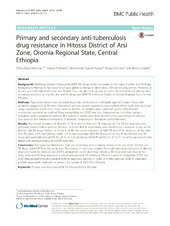| dc.contributor.author | Hamusse, Shallo Daba | en_US |
| dc.contributor.author | Teshome, Dejene | en_US |
| dc.contributor.author | Hassen, Mohammed Suaudi | en_US |
| dc.contributor.author | Demissie, Meaza | en_US |
| dc.contributor.author | Lindtjørn, Bernt | en_US |
| dc.date.accessioned | 2016-08-10T09:34:23Z | |
| dc.date.available | 2016-08-10T09:34:23Z | |
| dc.date.issued | 2016-07-18 | |
| dc.Published | BMC Public Health 2016, 16(1):593 | eng |
| dc.identifier.issn | 1471-2458 | |
| dc.identifier.uri | https://hdl.handle.net/1956/12538 | |
| dc.description.abstract | Background: Multidrug-resistant tuberculosis (MDR-TB) drugs which is resistant to the major first-line anti-TB drugs, Isoniazid and Rifampicin, has become a major global challenge in tuberculosis (TB) control programme. However, its burden at community level is not well known. Thus, the aim of study was to assess the prevalence of primary and secondary resistance to any first line anti-TB drugs and MDR TB in Hitossa District of Oromia Regional State, Central Ethiopia. Methods: Population based cross- sectional study was conducted on individuals aged ≥15 years. Those with symptoms suggestive of TB were interviewed and two sputum specimens were collected from each and examined using Lowenstein-Jensen (LJ) culture medium. Further, the isolates were confirmed by the Ziehl-Neelsen microscopic examination method. Drug susceptibility test (DST) was also conducted on LJ medium using a simplified indirect proportion method. The resistance strains were then determined by percentage of colonies that grew on the critical concentration of Isoniazid, Streptomycin, Rifampicin and Ethambutol. Results: The overall resistance of all forms of TB to any first-line anti-TB drug was 21.7 %. Of the total new and previously treated culture positive TB cases, 15.3 and 48.8 % respectively were found to be a resistant to any of the first-line anti-TB drugs. Further, of all forms of TB, the overall resistance of MDR-TB was 4.7 %. However, of the total new TB cases, 2.4 % had primary while 14.3 % had secondary MDR-TB. Resistance to any of the first-line anti-TB drugs (adjusted odd ratio (AOR), 8.1; 95 % CI: 2.26–29.30) and MDR-TB (AOR), 7.1; 95 % CI: 2.6–43.8) was found to be linked with previous history of anti-TB treatment. Conclusions: The study has identified a high rate of primary and secondary resistance to any of the first-line anti- TB drugs and MDR-TB in the study area. The resistance may have resulted from sub-optimal performance of directly observed treatment short-course (DOTS) programme in the detecting infectious TB cases and cure rates in the study area. Anti-TB drug resistance is linked with previous TB treatment. There is a need to strengthen DOTS and DOTS-Plus programmes and expand MDR-TB diagnostic facilities in order to timely diagnose MDR-TB cases and provide appropriate treatment to prevent the spread of MDR-TB in Ethiopia. | en_US |
| dc.language.iso | eng | eng |
| dc.publisher | BioMed Central | eng |
| dc.rights | Attribution CC BY | eng |
| dc.rights.uri | http://creativecommons.org/licenses/by/4.0 | eng |
| dc.subject | Primary and secondary MDR-TB | eng |
| dc.subject | Hitossa District | eng |
| dc.subject | Ethiopia | eng |
| dc.title | Primary and secondary anti-tuberculosis drug resistance in Hitossa District of Arsi Zone, Oromia Regional State, Central Ethiopia | en_US |
| dc.type | Peer reviewed | |
| dc.type | Journal article | |
| dc.date.updated | 2016-07-18T17:04:05Z | |
| dc.description.version | publishedVersion | en_US |
| dc.rights.holder | Copyright 2016 The Authors | |
| dc.identifier.doi | https://doi.org/10.1186/s12889-016-3210-y | |

